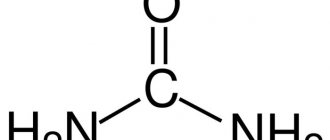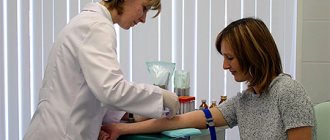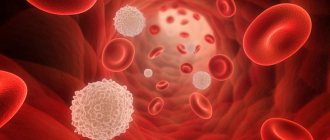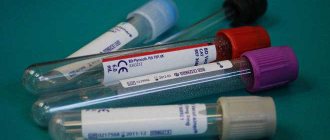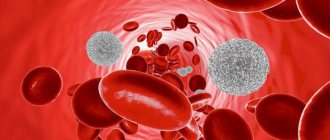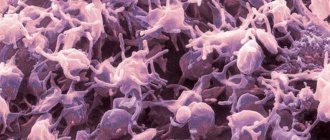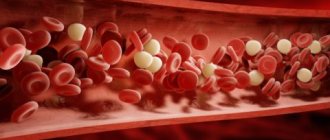Norm
Red blood cells in the bloodstream
Clinical blood tests allow us to determine the level of red blood cells in this biological fluid. Experts pay attention to both the quantity and quality of these cells. The interpretation of the tests should be carried out exclusively by a doctor. The norm of red blood cells in the blood of children is determined taking into account the age of the child. In babies under one year old, the number of red blood cells is higher. At two years of age, this indicator begins to normalize. At adult age, it is approximately equal to that of an adult.
| Baby's age | Acceptable limits of values, *1012 units/l |
| First day | from 5.0 to 7.0 |
| Fifth day | from 4.5 to 6.0 |
| Tenth day | from 4.5 to 5.5 |
| One month | from 4.0 to 5.0 |
| One year | from 4.0 to 4.5 |
| From two to five years | from 4.0 to 4.5 |
| Six to ten years | from 4.0 to 4.5 |
| Eleven to sixteen years old | from 4.0 to 5.5 |
There are two main types of erythrocytosis, deviations from the norm.
- Relative. At the same time, the number of cells themselves does not increase. Erythrocytosis is triggered by loss of plasma and is observed when blood thickens.
- Absolute. An increase in the red blood cells themselves is characteristic.
What to do when a child has low red blood cells?
A condition in which a child has a low level of red blood cells is called erythropenia (erythrocytopenia). Erythropenia is divided into 2 types:
- relative (false), in which the number of red cells remains at the same level, but the analysis shows the opposite. This can be caused by a large amount of fluid entering the blood, which leads to blood thinning.
- absolute, which occurs when there is insufficient production of red blood cells by the bone marrow. In addition, absolute thrombocytopenia occurs due to accelerated cell death due to blood loss.
Erythropenia in children
Erythropenia in children is characterized by a significant decrease in the concentration of red blood cells in the blood.
This pathology occurs in young patients after extensive blood loss, with various anemias and due to hemolysis. Hemolysis can be provoked by exposure to strong poisons or serve as a manifestation of hemolytic anemia.
A condition in which red blood cells are low causes oxygen starvation, which negatively affects the developing and growing child’s body. Erythropenia should alert the baby’s parents, since such a condition is not the norm, and therefore entails a lot of adverse consequences. If the diagnosis does not reveal any pathological causes for the development of erythrocytopenia, parents need to review the child’s diet and rule out any injuries.
Parents should not be frightened by low levels of red blood cells in a newborn child. In this case, the decrease in concentration is due to the action of maternal antibodies.
This condition often goes away on its own or while taking certain groups of medications.
Norms
| age | norm 1 million/mm3 |
| cord blood | 3,9-5,5 |
| 1-3 days | 4-7,2 |
| 4-7 days | 4-6,6 |
| 2-4 weeks | 3,6-6,2 |
| 1 month | 3-5,4 |
| 2 months | 2,7-4,9 |
| 3-11 months | 3,1-4,5 |
| 1-2 years | 3,6-4,9 |
| 3-12 years | 3,5-4,7 |
| 13-19 years old | 3,5-5,6 |
If low in the child’s blood
Causes
The reasons leading to relative erythropenia include the baby drinking a lot, as a result of which the blood is filled with excess fluid, which means that the quantitative ratio of cells decreases, but the volume remains unchanged.
Reasons that lead to absolute erythropenia:
- blood loss caused by injuries with severe damage to blood vessels, rupture of the liver or spleen. Blood loss in a child can be chronic, which occurs due to the presence of a stomach ulcer;
- insufficiency of red blood cell formation, which occurs due to a deficiency of B vitamins or folic acid in the child’s body;
- infections and parasites that lead to the rapid and active destruction of blood cells in the blood. In addition, some infections with their toxins negatively affect the bone marrow, which means that it produces less red blood cells;
- oncological diseases, in which the rapid destruction of red cells occurs. The decrease in level is also affected by the development of metastases;
- autoimmune diseases in which antibodies to red blood cells are produced;
- taking certain types of medications;
- heredity.
Symptoms and signs
The main symptoms of a decrease in red blood cells in a child’s blood are:
- paleness of the skin, lips and mucous membranes;
- increased fragility of nails and brittle hair;
- decreased appetite;
- development of non-standard taste preferences (chalk, lime, clay, paper, etc.);
- fast fatiguability;
- emotional depression;
- retardation in physical development.
With significant erythropenia, dizziness, tinnitus, and headaches occur. The condition is often characterized by visual disturbances, which are manifested by flickering “floaters” and white spots, and blurred vision.
Treatment
Treatment of blood erythropenia should begin only after a thorough diagnosis and discovery of the cause of its development. The baby will need to donate blood for additional research and undergo a number of instrumental diagnostic methods.
Treatment directly depends on the cause of the decrease in red blood cell concentration. As a rule, the child is prescribed to take iron supplements, B vitamins and folic acid. If erythropenia is caused by disorders of the bone marrow, the use of drugs that stimulate the production of red blood cells is recommended.
A decrease in red blood cells, the causes of which lie in acute blood loss, is treated with surgery and blood transfusion from a donor.
Prevention
Prevention of an acute decrease in red blood cells in a newborn baby’s blood begins with organizing breastfeeding, establishing the correct sleep and wakefulness regime, as well as taking iron supplements for preventive purposes (the latter is carried out only in consultation with a specialist!)
As the child grows up, it is necessary to carefully approach the issue of introducing complementary foods. Without exception, all additional products must be introduced into the diet strictly at the right time. Do not forget that the timing of the introduction of certain products was developed taking into account the characteristics of childhood, so it is very important to at least approximately adhere to the established rules.
In order to avoid a decrease in the level of red blood cells in children over 12 months of age, it is necessary to include in the diet foods that are rich not only in iron, but also in various microelements, such as:
- manganese;
- copper;
- cobalt;
- nickel;
- vitamins B, C, A;
- folic acid.
The largest amount of these beneficial substances is found in egg yolk, buckwheat and oatmeal, green peas, liver, red meat, beets and tomatoes, and potatoes.
Preventive measures also include regular stay in the fresh air, physical education and sports, and maintaining a healthy lifestyle.
No comments yet
1pokrovi.ru
Possible reasons for the increase
Stomach flu can affect the increase in red blood cells in the blood
Some factors that provoke the growth of red blood cells are not dangerous for the child and act for a short time. Others can cause consequences for the body. For example, a factor influencing erythrocytosis is living in a mountainous area. In this situation, a compensatory increase in red blood cells helps prevent mountain sickness.
Let's take a look at the main factors influencing the increase in the number of red blood cells:
- intestinal flu accompanied by diarrhea or vomiting;
- high temperature due to a viral disease;
- the result of physical activity;
- intensive sports activities;
- dry and hot air in the children's room;
- the baby is a passive smoker;
- consumption of bad water, passion for soda;
- result of burns;
- in newborns - a consequence of hypoxia.
Pathological factors include:
- congenital heart defect;
- pathological abnormalities in the functioning of the adrenal cortex;
- lung pathologies;
- hypernephroma;
- hematopoietic disorder;
- blood diseases;
- presence of oncology;
- obesity.
Erythrocytosis in children - causes
Erythrocytosis itself, the reasons that cause it, can be physiological or pathological. In the first case, the increase in the concentration of red blood cells is temporary and is associated with external factors, such as:
- intense sports training;
- accommodation in mountainous areas;
- lack of digestive enzymes;
- passive smoking;
- drinking poor quality water.
The pathological reasons that explain why red blood cells in a child’s blood are elevated are associated with the presence of a disease in the body. Among the common disorders in which high red blood cells are diagnosed, experts call:
- Congenital heart defect;
- diseases of the circulatory system;
- impaired lung function;
- problems with the spinal cord (the place where red blood cell synthesis occurs);
- excess body weight;
- tumor processes;
- dehydration of the body.
Primary erythrocytosis
Primary, or as it is often called, congenital erythrocytosis is associated with the presence of genetic defects in the body itself. As a result of such changes, the formation of hemoglobin is observed. Diseases of this form are often hereditary, and it is problematic to establish the exact reason why red blood cells are elevated in a child’s blood.
Secondary erythrocytosis
The secondary form develops against the background of an existing pathology in the body or as a result of prolonged exposure to certain factors on the body. An example of this would be physiological erythrocytosis. In this situation, under the influence of external factors, increased synthesis of red blood cells begins in the red brain.
Thus, children living in high mountain areas will constantly have an increased level of red blood cells in their blood. This is an adaptive reaction of the body to a lack of oxygen, which it tries to compensate for by increasing the volume of oxygen molecule carriers. This phenomenon is often referred to as symptomatic erythrocytosis.
Characteristic symptoms
Erythrocytosis may cause headaches
The following signs may indicate that a baby has true erythrocytosis:
- redness of the skin, the surface of the skin becomes pinkish, after which it darkens, sometimes acquiring a purplish-blue tint (changes are characteristic of all parts of the body and even the mucous membranes);
- Painful sensations in the fingers begin - it’s all due to a violation of vascular blood flow;
- paroxysmal pain may occur as a consequence of the presence of oxygen starvation in the tissues;
- headaches – problems with cerebral vessels;
- the size of the spleen may increase, since erythrocytosis causes overload of the organ;
- persistent hypertension is observed. This is typical for the presence of renal pathology. High blood pressure, in turn, affects vision problems and fatigue.
Diagnostics
When the number of red cells is slightly higher than normal, there is no need to worry. However, with a significant increase in this indicator, blood thickening may begin and thrombosis may occur. And this can lead to a heart attack, breathing difficulties, stroke, and brain pathologies.
During the study, attention is paid to the maturity and shape of red blood cells, hemoglobin value and hematocrit. The number of other cells in the bloodstream is also assessed. If a toddler is diagnosed with erythrocytosis, then he will be prescribed additional examination:
- Ultrasound;
- blood biochemistry;
- kidney x-ray;
- checking blood for gas composition.
Red blood cell indices will also be taken into account. These studies help establish the correct diagnosis. If anisocytosis is present, the specialist will look for the cause of the disease in the liver and suspect bleeding or folate deficiency anemia.
How to lower the level
- If the blood is very thick, bloodletting is sometimes necessary. This method is practiced in newborns. It is prescribed because thick blood is present in the body. If this is the case with an older baby, then he will be prescribed hirudotherapy. Sometimes oxygen therapy may be required. The teenager is prescribed erythrocytepheresis. After two courses, the desired indicator returns to normal.
- Blood thinners may be prescribed.
- The patient must follow a diet that excludes spicy and fatty foods. It is necessary that the diet be balanced. The presence of legumes, ginger, onions and almonds, buckwheat, oatmeal and wheat, dark chocolate, lemon and tomato is important. It is also recommended to consume sour berries, tomato juice and beets to thin the blood.
- It is important that the child drinks at least a liter of water per day, or better yet two. The baby needs to drink as much as possible. But don't give him soda.
- Ventilate and humidify the room in which the baby lives.
Precautionary measures
In order to prevent an increase in the number of red blood cells in the blood, it is necessary to follow certain recommendations.
- Take a clinical blood test at least once every six months to monitor these indicators.
- Excessive stress, both physical and psycho-emotional, should be avoided.
- If there are diseases of the respiratory system, treat them promptly.
- Protect your baby from inhaling tobacco smoke.
- Monitor what water your child drinks.
- Avoid drinking soda.
- Provide your child's diet with fruits and vegetables.
Now you know what causes of erythrocytosis may exist. As you can see, sometimes these are physiological factors, but pathologies are not excluded. Therefore, when diagnosing an elevated level of red blood cells, it is so important to conduct a more detailed examination of the child in order to identify what exactly affected the erythrocytosis. Don’t forget about precautions to prevent deterioration of your little one’s health.
Clinical blood test
A blood test is a laboratory test that provides information about your health status. Depending on what needs to be examined, the blood is collected in different tubes and analyzed in the laboratory. Tests will indicate the presence of infection, anemia or leukemia.
This test provides information about the number of red and white blood cells and platelets in children. This test provides the doctor with evidence of anemia. Using a blood smear in newborns, the doctor will evaluate the size, shape and possible pathological changes in children's red blood cells under a microscope. Bleeding disorders such as hemophilia are also detected through the test.
Blood is considered connective tissue because it consists of a fluid in which living cells are suspended. Indications of deviations from the normal value allow us to draw conclusions about diseases:
- Salts in tissues such as iron, sodium, potassium or calcium.
- Sugar level.
- Lipids such as cholesterol and triglycerides.
- Proteins and enzymes, eg albumin, gamma GT.
- Metabolites: uric acid or creatinine.
- Blood clotting factors.
- Tumor markers.
Chronic diseases increase the number of enzymes in studies. Using the number of red blood cells in a child, the therapist can determine whether the little patient is suffering from an infection in which bacteria have entered the blood, and what pathogenic microorganisms are involved.
Important information: What does it mean to have a reduced average red blood cell volume in a child?
